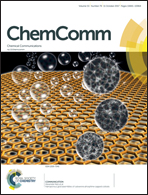Activation of the P–H bond by a frustrated Lewis pair and its application in catalytic Z-selective hydrophosphonylation of terminal ynones†
Abstract
The frustrated Lewis pair (FLP) comprised of B(C6F5)3 and 1,2,2,6,6-pentamethylpiperidine (PMP) can efficiently catalyze Z-selective hydrophosphonylation of terminal ynones with a Z/E selectivity of up to 20 : 1. Mechanistic studies suggest that the trans arrangement of the phosphite nucleophilic attack and hydrogen bond formation on the alkyne moiety is responsible for the observed Z-selectivity.



 Please wait while we load your content...
Please wait while we load your content...